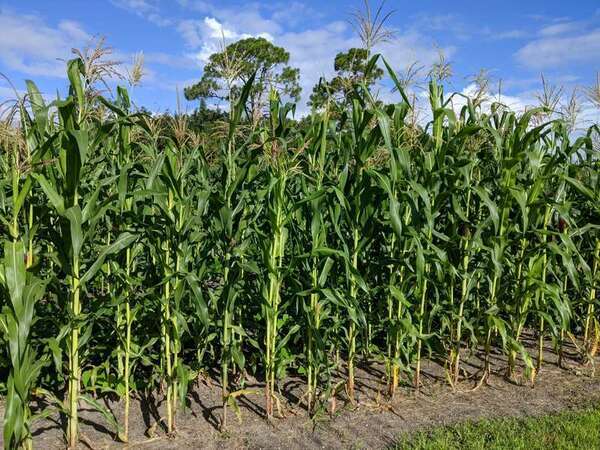Significance of maize for smallholders
Maize (Zea mays, L.) is a cereal crop grown in Tropical and Subtropical regions of the world as a food and feed source for human and livestock consumption. In Sub-Saharan Africa, half of the population is estimated to use maize as a staple food in their daily diet (Infonet Biovision, 2022). Maize kernels have high nutritive value providing carbohydrates, protein, vitamins, and minerals. Maize is consumed in a wide variety of ways including methods that utilize dry (maize meal, porridges, pastes, and beer) and fresh (baked, roasted, and boiled maize) ears. Maize economically impacts smallholders’ financial stability and is often grown, in part, for sale. Depending on the region where it is grown, grain, leaves, stalks, tassels, and cobs are marketable either for food or non-food products.
In the Global South, subsistence agricultural systems are predominant, but maize is a crop frequently used both for food and feed for the household and as a cash crop. However, many smallholder maize systems are unable to reach peak performance due to a lack of access or availability of high-quality inputs such as fertilizer, improved seed, irrigation, and labor. Additionally, a lack of access to good credit systems or co-op structures limits farmers’ involvement in markets.
Significant breeding efforts have been made over the past decades to help solve some of the problems encountered by small-scale farmers growing maize. Varieties of maize have been developed and released with improved overall yield, seed quality, and/or resistance/adaptation to biotic (e.g. pests and diseases) and abiotic (e.g. drought and heat) factors. In this article, we present the maize variety ‘KDV-1.’

Figure 17. 'KDV-1' maize at maturity. Source: Holly Sobetski
'KDV-1' (Figure 17)
The maize variety ‘KDV-1’ is an open-pollinated variety developed in Kenya as a Katumani composite9 and is adapted to arid, low altitude areas. It is a short-season (early maturing), white-seeded grain maize that is resistant to Maize Streak Virus (ECHO Staff, n.d.). Its production cycle is 45 to 52 days from seeding to tasseling and 75 to 90 days from seeding to harvest (mature ears; Dryland Limited, 2022). Recommended planting depth and spacing are 2-10 cm and 75-90 X 25-60 cm, respectively (Infonet Biovision, 2022). Deeper sowing (5 to 10 cm) and wider spacing (90 X 30-60 cm) is recommended for dryland areas. With a seed rate of 15-20 kg per hectare (ha), KDV-1 is expected to yield 15 to 42 90-kg bags/ha (2.2 to 3.8 metric tonnes/ha) (Dryland Limited, n.d).
Due to its earliness and resilience to drought, 'KDV-1' is a good option for farmers looking for a variety that safeguards their food security and resists negative impacts of climate change. 'KDV-1’ is also known to produce high quality seeds that farmers can save and use in subsequent planting seasons; the Kenya Agricultural and Livestock Research Organization (accessed 2022) recommends purchasing fresh seed after a third season of seed saving.
Farmers should be aware that:
- ‘KDV-1’ is an open-pollinated white-seeded grain variety and can cross with other maize varieties. This is relevant in regions where seed coat color plays a key role in people’s culinary choices. Where yellow seeded maize is grown and preferred, prevent cross pollination by not growing ‘KDV-1’ simultaneously with yellow seeded maize.
- 'KDV-1' is a field corn variety often used to make flour or to feed to livestock. The kernels are not as sweet tasting as those of sweet corn.
Conclusion
‘KDV-1’ is an early-maturing open-pollinated field corn variety adapted to dry areas. It has high yields with white kernels. With the adverse effects on crop production of ever-changing climatic patterns, ‘KDV-1’ holds promise for small-scale farmers looking for options to increase their food security, feed their livestock, and maintain their household’s financial stability. Active development workers who are members of ECHOcommunity.org may request a trial packet of seed. See the website for how to register as a member and how to order seeds.
References
Dryland Seed Limited. n.d. Maize – KDV1- Drought tolerant OPV’s. Crop Nutrition Laboratory Services Ltd. Accessed 11 March 2022. http://shambaza.com/listing/kdv1--drought-tolerant-opvs.html
ECHO Staff. n.d. Maize: KDV-1. ECHO Plant Descriptions. Accessed 11 March 2022. http://edn.link/ngmq6c
Infonet Biovision. n.d. Maize. Accessed 11 March 2022. https://infonet-biovision.org/PlantHealth/Crops/Maize
Kenya Agricultural and Livestock Research Organization (KALRO). n.d. Maize Agronomy. Accessed March 2022. https://www.kalro.org/maize/maize-agronomy/